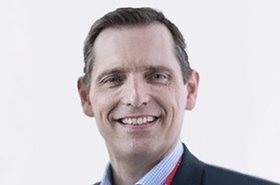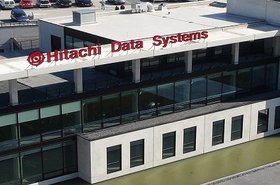The name Hitachi means different things to different people, such is the sheer number of products and technologies the company has produced over the past 100 years, from consumer tech to heavyweight industrials.
But Hitachi Energy is a new name, yet already operates in more than 90 countries, employing 40,000 professionals, and accruing sales of $10bn or so in the past year.
Dave Sterlace, account director for Data Centers at Hitachi Energy, explains how Hitachi Energy was formed, what it stands for, its roots, and its vision for a more sustainable future for data centers.
“Hitachi Energy comes from what was, most recently, ABB Power Grids, the power grids division of the Swiss-Swedish conglomerate. That ultimately goes back to two European companies, started 100 years ago. The company engaged in large-scale power projects – electrification and things like that, back when the industry was young.
“As time went by, we got more into things like microgrids and renewable integration. The large scale made it attractive for our parent company, Hitachi, and that's where we ended up.”
So, Hitachi Energy is a company you ought to know and a name you should be familiar with, but in a new, more all-encompassing form. So why the change and what does it say about the direction of the company?
“When we started looking at this transition, we realized that ‘power grids’ was a limiting statement, it implied power utilities, which are still our most important business and our biggest customer set.
“But it became evident that our customers are not just utilities: they are renewable energy generators; folks in the transportation sector, such as railways; and, increasingly, public transit agencies, bus fleet operators and truck fleet operators. Plus, of course, data center operators, so this diversification led us to the name Hitachi Energy as a more inclusive identity.”
Data centers are an important aspect of Hitachi Energy’s portfolio. It stems from the increasing role they play, not just as power consumers, but as innovators in the way that power is generated. Sterlace talks about the tipping point that brought the two into such close alignment:
“The data center industry grew and evolved, and became an industry in itself, rather than a support for other portions of the business. With the advent of cloud computing, data centers started getting bigger and bigger.
“Then, two things happened. First, it made sense for a company focused on large-scale power solutions, like Hitachi Energy, to become more involved. But also, the data center industry – because of its large and increasing power use – needed to be more cognizant of how that power was being used and become more efficient in its use of that power. As important, where was that power coming from. Was it sustainable, or were data centers contributing to the climate crisis?
“The goal, of course, is that eventually, through dedicated focus and continuous technology improvements, data centers will become much more sustainable in terms of power usage. All those factors, taken together, made it a really attractive proposition for us.”
You may think that data centers, operating at the bleeding edge of technology, would have taught the traditional power generators a thing or two, but Sterlace believes it’s the other way around.
“Data centers, believe it or not, were not just late to ‘industrialization’, but also late to the lessons learned from other industries. If you view data centers through a lens of being a process industry, like semiconductor fabrication or pharmaceuticals, where downtime can have wide-ranging knock-on effects, that's where data centers have been able to gain a lot of insight. That’s what our experience can bring.”
Among many other things, Hitachi Energy offers two key roles for data center providers: it provides a bridge between traditional energy grids and the companies using them, and it works to combine disparate energy sources in a more sustainable way.
Sterlace explains how those two seemingly unconnected functions come together: “We already work with all the large-scale household names in terms of ‘hyper-scale’ and cloud service providers, as well as many regional and smaller scale co-locators. With the explosion of data, from things like work from home, it makes more sense for people to have a bigger data center footprint.
“We're not waiting for developments in the future, we can help right now by removing greenhouse gases from the products, by removing carbon from our supply chain – including powering our manufacturing with fossil-free energy – and being transparent on how we're doing it,” says Sterlace.
One of the burgeoning sectors that brings together data centers and traditional power grids is the microgrid concept. It’s not a new concept in itself, but one with a history as long as the power industry – the idea of the plant as a power grid in its own right. Hitachi Energy has therefore been working with microgrids for a long time.
“We have vast experience in microgrids going back 30 or 40 years, initially for places where utility power wasn't practical, like far-flung mining operations in the Australian outback, for example.”
But how have we moved from outback mining to smart cities and data centers?
“With time, that evolved into how to integrate multiple power sources for things like municipal stadiums needing power to run lights at night: how do you integrate renewables into that? The most interesting thing is that there isn’t an overall solution; it’s an approach that involves fine-tuning all the time.
“As new technology emerges, we're using digital techniques and digital monitoring, digital control and automation to make a system that isn’t just adaptable for the future but can also take advantage of everything we can do right now.”
Education for a better future
Sterlace describes the role Hitachi Energy also plays as an educator, opening the eyes of businesses to what is possible, and guiding them through some of the big changes that are to come. After all, trying to make a move before technology is suitably mature can be as disastrous as leaving it too late.
“The upshot is that you don't have to sit there and have it idle for a few years, hoping the price of hydrogen, for example, comes down or becomes more readily available.
“Data centers already incorporate many of the key elements of a microgrid, they just generally haven’t functioned that way, instead relying on utilities for their baseload needs and utilizing generators for backup when power isn’t available from the grid. We can bring our experience running microgrids to change that to a more interactive proposition, where data center operators can take a more active role in addressing and managing their energy needs locally, utilizing a more diverse mix of energy sources.”
There are certain tangible benefits from working with an energy partner with a wide range of in-house skills. A primary example is visibility, adds Sterlace.
“Near real-time, or real-time, data is key for that type of decision making. It's as easy as the old adage, ‘you can't manage what you can't measure.’ When you can, all of a sudden it changes that equation significantly. You have to know what, say, a power transformer is doing and its health throughout its life.
“Data center operators don't normally think like that, they're typically closer to the compute side. A better way to utilize our resources is to do something like predictive maintenance versus waiting for something to break. Better insight means you're using your dollars more wisely.”
One clear message is that Hitachi Energy doesn’t just sell products; it provides solutions. That’s why Sterlace is keen to emphasize the importance of open monitoring solutions in a fast-changing marketplace.
“Open-source communications protocols are growing more important because the last thing you want is to be stuck in a proprietary system that's either tied to a particular technology or tied to a particular ‘house brand’ protocol that isn't future-proof.”
Hitachi Energy is positioning itself not just as a company looking inward toward microgrids in data centers, but outward to the community and, of course, the planet. The business is already involved in creating a more diverse workforce, but that too has its challenges.
“We’re focusing on increasing the ratio of women to men and my personal cause is to get more veterans involved. But getting new minds interested in a company like Hitachi Energy is a challenge. It can seem more enticing to work for some of our clients, but we’re doing so many cool things, particularly around sustainability.
“So, we're partnering with local organizations, specifically on workforce development, including support programs at community colleges. Even at high school level we need to get people up to speed on the skills so they can contribute to this industry and take part in it.”
Education is clearly an important aspect of what Sterlace and the business does: educating clients and communities could all have a positive impact on the future of the planet, says Sterlace.
“There's a lot to be said for education about the industry for society as a whole, because if I walked up to someone on the street and said, ‘Do you know what a data center is?’, the likelihood is they'd say ‘no’.
“People need to know it’s not just turning light switches on and off, but knowing how much power they’re using every time they pick up their phone, fixing the intellectual disconnect for people who think of their phone and its energy use in an abstract way.”
But environmental impacts don’t stop with education. Companies have to put their money where their mouth is and Hitachi Energy is leading the way, as Sterlace explains. “One of our key focuses is to be carbon neutral by 2030, so we've gone to 100 percent fossil-free energy in electricity for operations. And we're trying to use direct renewables and, indeed, getting closer to 24/7 sustainability.
“Hitachi, our parent company, is very focused on things like the UN Sustainable Development Goals, and we definitely follow those four pillars, which are planet, people, peace and partnerships. We're stewards of the Earth; we need to be able to manage what and how we consume in a more sustainable way for future generations.”
To find out more about Hitachi Energy, click here.
More from Hitachi
-

Sponsored Achieving sustainability across the entire data center power supply chain
Considering the variable nature of renewable energy, achieving a sustainable power supply is fraught with challenges, but for Hitachi Energy, where there are obstacles, there is an opportunity to innovate
-

Carbon neutral data centers are a key part of IT’s sustainability drive
And a good starting point is to optimize apps and data
-

Hitachi launches sovereign cloud service in Japan
Company to offer secure cloud service from Hitachi-managed facilities

